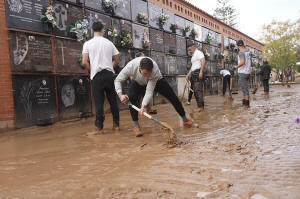Spanish residents appeal for help, 3 days after historic floods left at
least 158 dead
 Send a link to a friend
Send a link to a friend
 [November 01, 2024]
By TERESA MEDRANO [November 01, 2024]
By TERESA MEDRANO
MADRID (AP) — Three days after historic flash floods swept through
several towns in southern Valencia, in eastern Spain, the initial shock
was giving way to anger, frustration and a wave of solidarity on Friday.
Many streets are still blocked by piled-up vehicles and debris, in some
cases trapping residents in their homes. Some places still don't have
electricity, running water, or stable telephone connections.
Residents turned to media to appeal for help.
“This is a disaster. There are a lot of elderly people who don’t have
medicine. There are children who don’t have food. We don’t have milk, we
don’t have water. We have no access to anything,” a resident of Alfafar,
one of the most affected towns in south Valencia, told state television
station TVE. “No one even came to warn us on the first day.”
So far 158 bodies have been recovered — 155 in Valencia, two in the
Castilla La Mancha region and one more in Andalusia — after Spain's
deadliest natural disaster in living memory. Members of the security
forces and soldiers are busy searching for an unknown number of missing
people, many feared to still be trapped in wrecked vehicles or flooded
garages.
And as authorities repeat over and over, more storms are expected. The
Spanish weather agency issued alerts for strong rains in Tarragona,
Catalonia, as well as part of the Balearic Islands.
Meanwhile, flood survivors and volunteers are engaged in the titanic
task of clearing an omnipresent layer of dense mud.
Residents in communities like Paiporta, where at least 62 people died,
and Catarroja, have been walking kilometers (miles) to Valencia to get
provisions, passing neighbors from unaffected areas who are bringing
carry water, essential products or shovels to help remove the mud.
Juan Ramón Adsuara, the mayor of Alfafar, one of the hardest hit towns,
said the aid isn't nearly enough for residents trapped in an “extreme
situation.”

[to top of second column]
|

People clear away mud from inside a flood damaged cemetery on the
outskirts of Valencia, Spain, Friday, Nov. 1, 2024 after flooding in
the region. (AP Photo/Alberto Saiz)

“There are people living with corpses at home. It’s very sad. We are
organizing ourselves, but we are running out of everything," he told
reporters. "We go with vans to Valencia, we buy and we come back, but
here we are totally forgotten.”
Rushing water turned narrow streets into death traps and spawned rivers
that tore through homes and businesses, leaving many uninhabitable.
Social networks have channeled the needs of those affected. Some posted
images of missing people in the hope of getting information about their
whereabouts, while others launched initiatives such as Suport Mutu — or
Mutual Support — which connects requests for help with people who are
offering it; and others organized collections of basic goods throughout
all the country or launched fundraisers.
Spain’s Mediterranean coast is used to autumn storms that can cause
flooding, but this was the most powerful flash flooding in recent
memory. Scientists link it to climate change, which is also behind
increasingly high temperatures and droughts in Spain and the heating up
of the Mediterranean Sea.
Human-caused climate change has doubled the likelihood of a storm like
this week’s deluge in Valencia, according to a partial analysis issued
Thursday by World Weather Attribution, a group made up of dozens of
international scientists who study global warming’s role in extreme
weather.
Spain has suffered through an almost two-year drought, making the
flooding worse because the dry ground was so hard that it could not
absorb the rain.
In August 1996, a flood swept away a campsite along the Gallego river in
Biescas, in the northeast, killing 87 people.
All contents © copyright 2024 Associated Press. All rights reserved |